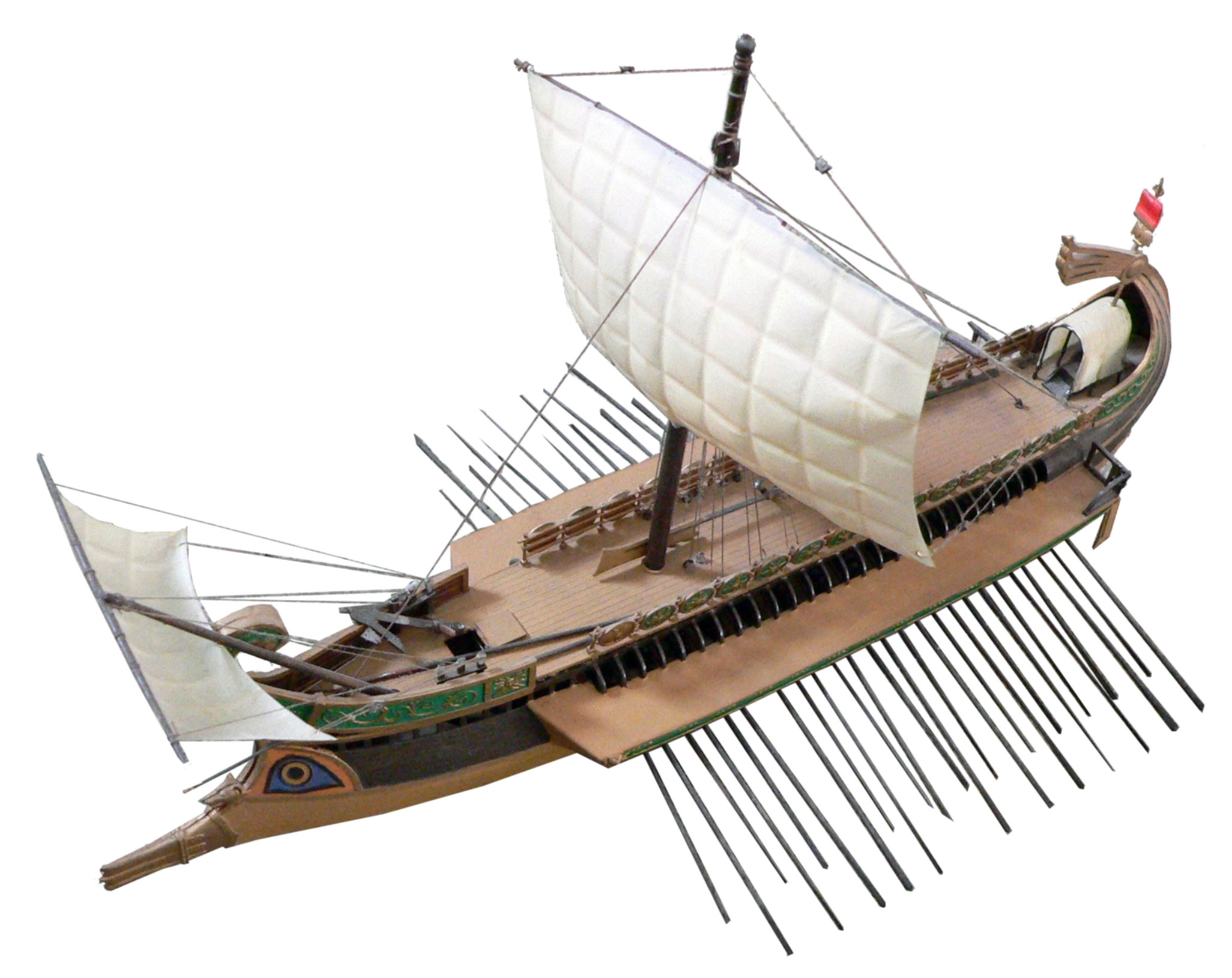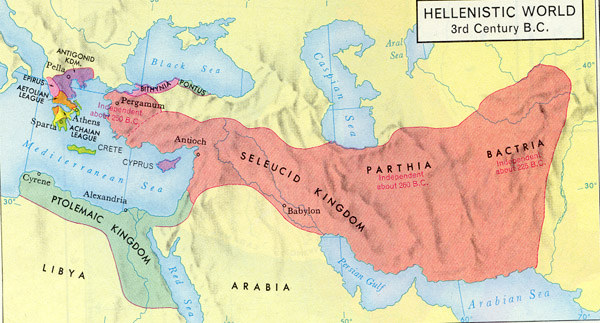A. The Athens-Sparta Rivalry--these two cities were the pre-eminent Greek city-states of the Archaic and Classical periods. The different character of these two cities underscores the diversity of human societies, even when they share similar climates and cultures.
1. Sparta--Sparta's unique (to Greece) solution for handling the conundrum of an exploding population and lack of arable land--the annexation of Messenia and the enslavement of its population--changed Sparta politically and, eventually, culturally.
a. Land near Sparta and Messenia was divided into several thousand lots and assigned to Spartan citizens. The helots (the enslaved population of Messenia) worked the land and turned over a portion of what they grew to their Spartan masters who, being freed from the work of food production, could spend their lives in military training and service.
b. The Spartan army was undoubtedly the finest in Greece, far superior, militarily, than the citizen militias of the other city-states. Military training for Spartan boys began at age seven, when they were taken from their families and placed in barracks, under strict discipline, often placed in conditions of deprivation, to prepare them for such conditions on the battlefield.
c. A Spartan male's whole life was subordinated to the military needs of the state. Sparta essentially stopped the cultural clock at about 500BCE, and took no part in the flowering of Greek culture that occurred during the Archaic period.
d. Sparta's military might was largely used to ensure that there was no uprising of the helots; after proving their bravery and military skill early in the Archaic period, Sparta's military prowess became a given, and few rivals felt the need to test it. The need to remain in close range of Sparta meant that the city-state adopted a cautious and isolationist foreign policy.
2. Athens--Athens was also fairly unique in Greece. It lies in a fairly prosperous region, with a larger plains area suitable for the cultivation of grain and olive trees, which also supported numerous villages and several larger towns--all of which became satellites of Athens.
a. Political turmoil--by 594BCE, Athens was on the verge of a civil war, as aristocratic families vied for control of the city. To reduce this growing conflict, a respected member of the elite class, Solon, was given extraordinary powers as a lawgiver. First, he divided Athenians into four classes, based upon the annual yield of their farms. Those members of the top three social classes were granted the right to hold political office, while members of the lowest class could not. While this arrangement cannot really be classified as democracy, it did break the political stranglehold wealthy aristocratic families had exercised in Athens.
b. Continued political turmoil--despite this broadened political base, political turmoil continued in Athens until 546BCE, when an aristocrat named Pisistratus seized power as a tyrant. To strengthen his position and weaken the power of the other members of the aristocracy, Pisistratus began a major building program (he is responsible for the construction of the Temple of Athena on the Acropolis) to provide public space in the city that, in conjunction with an expanded program of festivals, religious processions, play performances, athletic contests, and the equivalent of modern-day "poetry slams" to entice people in the hinterland to identify with Athens, were he was most popular. In large part, this strategy worked, and he was able to pass on the leadership of the city on to his son.
c. Pericles and Athenian Democracy--the son of Pisistratus proved to be somewhat less popular, and in the last decade of the sixth century BCE, with the assistance of Sparta, the Athenians turned out the ruling family. By the middle of the fifth century (between 460 and 450BCE), Pericles and his political allies took the last step in the evolution of Athenian democracy, and transferred all power to popular organs of government: the Assembly, the Council of 500, and the People's Courts. Now men of moderate or small means could participate fully in the political process, even filling the highest positions, because government officials were now paid, so they could afford to take time from work. the focal point for governing Athens quickly became the Assembly, where several times a month proposals were debated, decisions were made openly, and any citizen could speak to the issues of the day.
B. Wars Between Persia and Greece, 546-323BCE--this series of wars was probably more meaningful to the Greeks, who saw the Persians as a threatening enemy, while Persia was more concerned with rivals to the east. Before Persia was a threat, however, Athens tried to enlist the kingdom as an ally in its struggle against the influence of Sparta. Finding the price of alliance too high, Athens let the matter drop--but never informed Persia, which continued to regard Athens as a vassal state.
1. Early Encounters, 546-499BCE--Cyrus' conquest of Lydia in 546BCE led to the subjugation of the Greek city-states on the Anatolian coast, called by the Greeks Ionia. In the years that followed, local groups or individuals who collaborated with the Persians ruled their home cities with minimal Persian interference as tyrants--but tyrants with little local support. All of this changed with the Ionian Revolt, when the Greeks and other subject peoples on the western frontier of the Persian Empire took up arms to wrest control from Persia. After five years and a massive infusion of troops, the rebellion was finally put down.
a. First Persian War, 490BCE--Darius dispatched his army to punish Eretria and Athens, the two mainland city-states that had aided the Ionian rebels. Eretria was betrayed to the Persians, and the survivors were marched of to permanent exile in southwestern Iran. The Athenians probably would have suffered a similar fate, but their hoplites defeated the more numerous but lighter-armed Persian troops at the battle of Marathon, 26 miles from Athens.
c. On the Offensive--Athens stubborn refusal to submit, and the vital role its navy had played in defeating the Persian advance--coupled with the losses Sparta had suffered at Thermopylae, and Sparta's preferred isolationist stance--made Athens the natural choice to lead a counter-offensive to liberate those Greek states still under Persian control. The formation of the Delian League (477BCE), initially a voluntary alliance of Greek states and led by Athens, permitted them to sweep the Persians from the waters of the eastern Mediterranean within twenty years.
2. The Height of Athenian Power--the reluctance of other Greek states to continue to supply troops for this enterprise allowed Athens to transform the Delian League from a voluntary association to a means of dominating the other city-states.
a. Naval technology--Athens transformed naval technology with the development of the trieme, a sleek, fast vessel that was powered by 170 rowers, in addition to its sail power. This new naval technology is also a reflection of the changed Athenian political climate; while hoplites had provided their own armor, and thus had been part of the middle class, rowers came predominately from the lower orders, and their importance to ensuring the supremacy of the trieme made it difficult to deny them greater political power.
b. Pre-eminent Trade Center--Athen's port, Piraeus, became the most important commercial center in the eastern Mediterranean, and Athens did not hesitate to use its naval power to promote its economic interests. Subject states were forced to pay tribute, and Athenian political leaders like Pericles used this tribute money to build monuments and temples on the Acropolis--as well as buildings throughout the city, thereby transferring the tribute money to the citizens of Athens though wages and goods for buildings these structures.
4. Inequality in Classical Greece--Athenian democracy was enjoyed by a relatively few men, perhaps 30,000 to 40,000, out of a total population in Athens of some 300,000 people.
a. Slave--slaves made up possibly one-third of the population of Classical Athens, and did nearly all of the word; in fact, it was the labor of slaves that made it possible for Athenian men to engage in the democratic process. Greeks like Aristotle rationalized the institution of slavery by arguing that the barbaroi lacked the capacity to reason, and thus were better off under the direction of rational Greek owners--an argument that would be made again and again in history to legitimize slavery.
b. Women--the status of women varied from state to state in Classical Greece. Ironically, women were perhaps the most free in Sparta, where they were expected to raise strong virile children, and enjoyed a level of visibility and outspokenness that shocked other Greeks; in Athens, women were perhaps the most oppressed, where men attempted to confine them to the home to reign in their alleged promiscuousness. In Athenian society, the main role of women was to produce children, and preferably male children, since female offspring were more likely to suffer from infanticide.
5. Failure of the City-State and the Triumph of Macedonia
a. Peloponnesian War (431-404BCE)--resentment towards the high-handed attitude of Athens led a number of other city-states, under the direction of Sparta, to begin the two-decade long Peloponnesian War. During the early years of the conflict, Athens refused to engage the invading army outside the walls it had constructed to connect it to the port of Piraeus; the hoplites that made up the bulk of the attacking force would have to withdraw during the year to harvest the crops at their farms. With the financial assistance of Persia, however, Sparta was able to build a navy to defeat the Athenians, and Sparta quickly assumed Athens place as the most despised city-state because of its own haughty attitude. The skirmishing continued in Greece until the king of Persia brokered the King's Peace in 387BCE. Problems in the eastern portion of the empire diverted Persian attention elsewhere, but the position of the King of Persia as the guarantor of the status quo kept the Greek city-states in a weakened condition.
c. Alexander the Great--used the military innovations of his father, and the avowed goal of revenging Xerxes invasion of Greece, to roll through the Persian Empire, eventually reaching the Indus Valley. Also demonstrating that he could learn from his avowed enemy, he maintained the framework of the Persian administration, while replacing the administrators themselves with those personally loyal to him--while at the same time, marrying several well-connected Persian and Iranian women, and adopting Persian-style dress and some customs--much to the dismay of the Macedonian nobility. His death in 323BCE ended this controversy.
C. The Hellenistic Sythesis, 323-30BCE
1. The Three Kingdoms--the short-lived Macedonian dynasty was broken into three kingdoms after Alexander's death: Seleucid, Ptolemaic, and Antigonid.
a. Selucid--took over the bulk of the empire, and promptly lost great portions of it--the Indus Valley and Afghanistan, and most of Iran by the middle of the second century BCE. From their capital is Syrian Antioch, the Selucid monarchs controlled Mesopotamia, Syrian, and parts of Anatolia
b. Ptolemies--ruled Egypt, which was more homogenous than the Selucid kingdom, and easier to control. The Ptolemies ruled from Alexandria, planned by Alexander himself. The Ptolemies were happy to collect taxes from the rich agricultural lands, but did little to attempt to integrate Egyptians into the kingdom; only the last Ptolemy ruler, Cleopatra (51-30BCE) even bothered to learn the Egyptian language.
c. Antigonids--ruled over the ethnically homogeneous region of Macedonia and northern Greece. While they maintained garrisons in the southern part, and the threat of invasion kept the southern city-states in line, they did not control southern Greece. The southern city-states banded together in various alliances, except for Sparta and Greece. Sparta continued to believe its own myth of invincibility, even while losing battles to Macedonia, and Athens was content to remain neutral, an educational center.
2. Alexandria--was the premier city of the Hellenistic Age, the center of learning, culture, and Greek-style democracy.
D. Conclusion












No comments:
Post a Comment